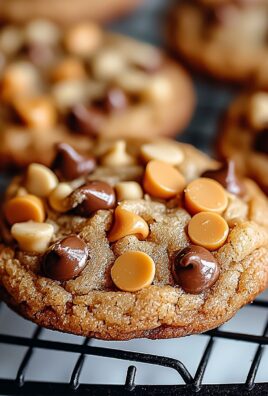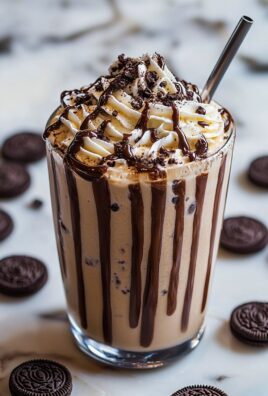German Cheesecake, or Käsekuchen as it’s known in Germany, is a dessert that’s so much more than just cheesecake. Imagine sinking your fork into a cloud of creamy, subtly sweet filling, nestled in a buttery, crumbly crust. Forget the dense, intensely sweet cheesecakes you might be used to; this is a lighter, more delicate experience that will leave you wanting more. Have I got your attention?
This beloved dessert has a rich history, with variations found throughout Germany and neighboring countries. While its exact origins are debated, the concept of a baked cheese dessert dates back centuries. What sets German Cheesecake apart is its unique filling, often made with quark, a fresh dairy product that lends a distinctive tang and lightness.
People adore this cheesecake for its perfect balance of flavors and textures. The smooth, almost ethereal filling contrasts beautifully with the slightly crisp crust. It’s not overly sweet, making it a delightful treat that can be enjoyed any time of day. Plus, while it looks impressive, it’s surprisingly simple to make at home. So, are you ready to bake a little bit of German happiness? Let’s get started!
Ingredients:
- For the Crust:
- 1 1/2 cups all-purpose flour
- 1/4 cup granulated sugar
- 1/2 teaspoon salt
- 1/2 cup (1 stick) cold unsalted butter, cut into cubes
- 1 large egg
- 2-3 tablespoons ice water
- For the Filling:
- 3 pounds (1360g) cream cheese, softened to room temperature
- 1 3/4 cups granulated sugar
- 1/4 cup all-purpose flour
- 1 teaspoon vanilla extract
- 1/2 teaspoon lemon zest
- 1/4 teaspoon salt
- 6 large eggs
- 1 cup heavy cream
- Optional Topping:
- Sour cream topping (recipe follows)
- Fresh fruit (berries, sliced peaches, etc.)
Preparing the Crust:
- Combine Dry Ingredients: In a large bowl, whisk together the flour, sugar, and salt. This ensures the salt and sugar are evenly distributed throughout the flour.
- Cut in the Butter: Add the cold, cubed butter to the flour mixture. Using a pastry blender or your fingertips, cut the butter into the flour until the mixture resembles coarse crumbs. The smaller the butter pieces, the flakier the crust will be. Be careful not to overwork the butter, as this will result in a tough crust.
- Add the Egg: In a small bowl, lightly beat the egg. Pour the egg into the flour mixture.
- Add Ice Water: Gradually add the ice water, one tablespoon at a time, mixing until the dough just comes together. Be careful not to add too much water, as this will make the crust tough. The dough should be slightly sticky but not wet.
- Form the Dough: Gently form the dough into a disc. Wrap the disc in plastic wrap and refrigerate for at least 30 minutes, or up to 2 hours. This allows the gluten to relax, resulting in a more tender crust.
- Roll Out the Dough: On a lightly floured surface, roll out the dough to a 12-inch circle. The dough should be about 1/8 inch thick.
- Transfer to Pan: Carefully transfer the dough to a 9-inch springform pan. Press the dough into the bottom and up the sides of the pan.
- Pre-bake the Crust: Prick the bottom of the crust with a fork to prevent it from puffing up during baking. Line the crust with parchment paper and fill with pie weights or dried beans. This will help the crust maintain its shape. Bake in a preheated oven at 350°F (175°C) for 15 minutes.
- Remove Weights and Bake Again: Remove the parchment paper and pie weights. Bake for another 5-7 minutes, or until the crust is lightly golden brown. Let the crust cool completely before adding the filling.
Preparing the Filling:
- Cream the Cream Cheese: In a large bowl, beat the softened cream cheese with an electric mixer until smooth and creamy. It’s crucial that the cream cheese is at room temperature to avoid lumps in the filling.
- Add Sugar and Flour: Gradually add the sugar and flour to the cream cheese, beating until well combined. The flour helps to stabilize the cheesecake and prevent it from cracking.
- Add Vanilla, Lemon Zest, and Salt: Stir in the vanilla extract, lemon zest, and salt. The lemon zest adds a subtle brightness to the cheesecake.
- Add Eggs: Add the eggs one at a time, beating well after each addition. Be careful not to overbeat the eggs, as this can incorporate too much air into the filling, which can cause the cheesecake to puff up and then collapse.
- Add Heavy Cream: Stir in the heavy cream until just combined. The heavy cream adds richness and moisture to the cheesecake.
Baking the Cheesecake:
- Pour Filling into Crust: Pour the cream cheese filling into the prepared crust. Smooth the top of the filling with a spatula.
- Bake in a Water Bath: Wrap the bottom of the springform pan tightly with aluminum foil. This will prevent water from seeping into the cheesecake. Place the springform pan in a larger roasting pan. Pour hot water into the roasting pan until it reaches about halfway up the sides of the springform pan. The water bath helps to create a moist environment in the oven, which prevents the cheesecake from cracking.
- Bake: Bake in a preheated oven at 325°F (160°C) for 70-80 minutes, or until the edges of the cheesecake are set but the center is still slightly jiggly.
- Cool Gradually: Turn off the oven and crack the oven door slightly. Let the cheesecake cool in the oven for 1 hour. This gradual cooling helps to prevent the cheesecake from cracking.
- Refrigerate: Remove the cheesecake from the water bath and let it cool completely on a wire rack. Then, cover the cheesecake with plastic wrap and refrigerate for at least 4 hours, or preferably overnight. This allows the cheesecake to set completely and develop its flavor.
Optional Sour Cream Topping:
- Ingredients:
- 1 cup sour cream
- 2 tablespoons granulated sugar
- 1 teaspoon vanilla extract
- Combine Ingredients: In a small bowl, whisk together the sour cream, sugar, and vanilla extract until smooth.
- Spread on Cheesecake: Spread the sour cream topping evenly over the top of the cooled cheesecake.
- Bake Briefly: Bake in a preheated oven at 350°F (175°C) for 5-7 minutes, or until the topping is set.
- Cool and Refrigerate: Let the cheesecake cool completely on a wire rack. Then, cover the cheesecake with plastic wrap and refrigerate for at least 2 hours before serving.
Serving the Cheesecake:
- Remove from Pan: Run a thin knife around the edge of the cheesecake to loosen it from the springform pan. Carefully release the sides of the pan.
- Slice and Serve: Slice the cheesecake with a sharp knife. Serve chilled, plain or with fresh fruit. Berries, sliced peaches, or a drizzle of chocolate sauce are all delicious options.
Tips for Success:
- Use Room Temperature Ingredients: Make sure the cream cheese, eggs, and heavy cream are all at room temperature before you start baking. This will help to ensure that the cheesecake is smooth and creamy.
- Don’t Overbeat the Filling: Overbeating the filling can incorporate too much air, which can cause the cheesecake to puff up and then collapse.
- Bake in a Water Bath: Baking the cheesecake in a water bath helps to create a moist environment in the oven, which prevents the cheesecake from cracking.
- Cool Gradually: Cooling the cheesecake gradually helps to prevent it from cracking.
- Refrigerate for at Least 4 Hours: Refrigerating the cheesecake for at least 4 hours allows it to set completely and develop its flavor.
Troubleshooting:
- Cracked Cheesecake: A cracked cheesecake is usually caused by baking it at too high of a temperature or cooling it too quickly. To prevent cracking, bake the cheesecake in a water bath and cool it gradually in the oven.
- Soggy Crust: A soggy crust is usually caused by not pre-baking it long enough or by using too much liquid in the filling. To prevent a soggy crust, pre-bake it until it is lightly golden brown and be careful not to overbeat the filling.
- Lumpy Filling: A lumpy filling is usually caused by using cold cream cheese. Make sure the cream cheese is at room temperature before you start baking.
Variations:
- Chocolate Cheesecake: Add 1/2 cup of unsweetened cocoa powder to the filling.
- Lemon Cheesecake: Add 2 tablespoons of lemon juice to the filling.
- Strawberry Cheesecake: Swirl strawberry jam or puree into the filling before baking.
- Oreo Cheesecake: Crush Oreo cookies and add them to the filling.

Conclusion:
This German Cheesecake isn’t just another dessert; it’s a taste of tradition, a slice of comfort, and a guaranteed crowd-pleaser. The creamy, subtly sweet filling, perfectly balanced with the delicate crust, creates a symphony of flavors and textures that will leave you wanting more. I truly believe this recipe is a must-try for anyone who appreciates a classic, well-executed dessert. It’s surprisingly simple to make, yet the results are undeniably impressive.
Why is this German Cheesecake a must-try? Because it’s more than just a recipe; it’s an experience. It’s the perfect balance of sweet and tangy, rich and light. It’s the kind of dessert that evokes memories and creates new ones. It’s the perfect ending to any meal, or a delightful treat to enjoy with a cup of coffee or tea. Plus, the recipe is incredibly forgiving, making it ideal for both seasoned bakers and those just starting out. You really can’t go wrong!
But the best part? The versatility! While this recipe is fantastic as is, there are so many ways to customize it to your liking. For a richer flavor, try using full-fat cream cheese and adding a touch of vanilla extract to the filling. If you prefer a slightly tangier cheesecake, increase the amount of lemon juice.
Serving Suggestions and Variations:
* Classic Presentation: Serve chilled, sliced into wedges, and garnished with a dusting of powdered sugar.
* Berry Bliss: Top each slice with fresh berries like strawberries, raspberries, or blueberries for a burst of fruity flavor. A simple berry compote would also be divine.
* Chocolate Indulgence: Drizzle melted chocolate over the cheesecake or add chocolate shavings for a decadent twist.
* Citrus Zest: Enhance the citrus notes by adding orange or lemon zest to the filling.
* Spiced Delight: For a warm and cozy flavor, add a pinch of cinnamon or nutmeg to the filling.
* Cookie Crumbles: Use crushed graham crackers or shortbread cookies for the crust for a different textural experience.
* Individual Cheesecakes: Bake the batter in muffin tins for adorable individual cheesecakes, perfect for parties or portion control.
I’m so excited for you to try this recipe and discover the magic of homemade German Cheesecake. It’s a dessert that’s sure to impress your family and friends, and it’s a recipe you’ll want to make again and again.
So, what are you waiting for? Gather your ingredients, preheat your oven, and get ready to bake! I promise you won’t be disappointed. And most importantly, have fun with it! Baking should be enjoyable, so don’t be afraid to experiment and make it your own.
Once you’ve tried this recipe, I’d love to hear about your experience! Share your photos and comments on social media using [Your Hashtag] or leave a review on the blog. Let me know what variations you tried and how they turned out. I’m always looking for new ideas and inspiration, and I can’t wait to see your creations! Happy baking! I hope you enjoy this recipe as much as I do. Let me know what you think!
German Cheesecake: The Ultimate Guide to Baking Perfection
A creamy, no-crust cheesecake with a hint of lemon, baked until golden brown. Perfect for a light and delicious dessert.
Ingredients
- 750g Quark (20% fat)
- 150g sugar
- 1 package vanilla pudding powder
- 125ml milk
- 3 eggs
- Grated zest of 1 lemon
- 100g melted butter
Instructions
- Den Ofen auf 175 °C (Ober-/Unterhitze) vorheizen.
- Eine Springform (26 cm Durchmesser) mit Backpapier auslegen.
- Für den Teig Mehl, Zucker, Salz, Butter und Ei in eine Schüssel geben und zu einem glatten Teig verkneten.
- Den Teig in die Springform geben und dabei einen Rand hochziehen.
- Für die Füllung Quark, Zucker, Eier, Vanillepuddingpulver, Zitronensaft und Zitronenabrieb in einer Schüssel verrühren.
- Die Füllung auf den Teigboden geben.
- Den Kuchen im vorgeheizten Ofen ca. 60-70 Minuten backen.
- Den Kuchen nach dem Backen im ausgeschalteten Ofen bei leicht geöffneter Tür auskühlen lassen.
- Vor dem Servieren mit Puderzucker bestäuben.
Notes
- The dough must not be moved during the resting period.
- More cloves can be used for a more intense garlic flavor.
“`





Leave a Comment